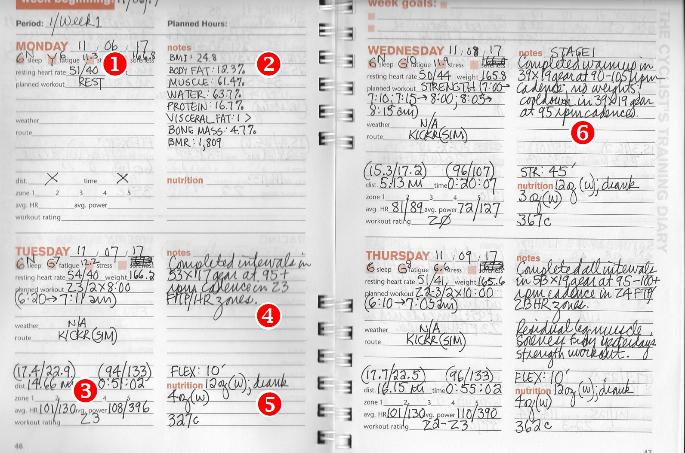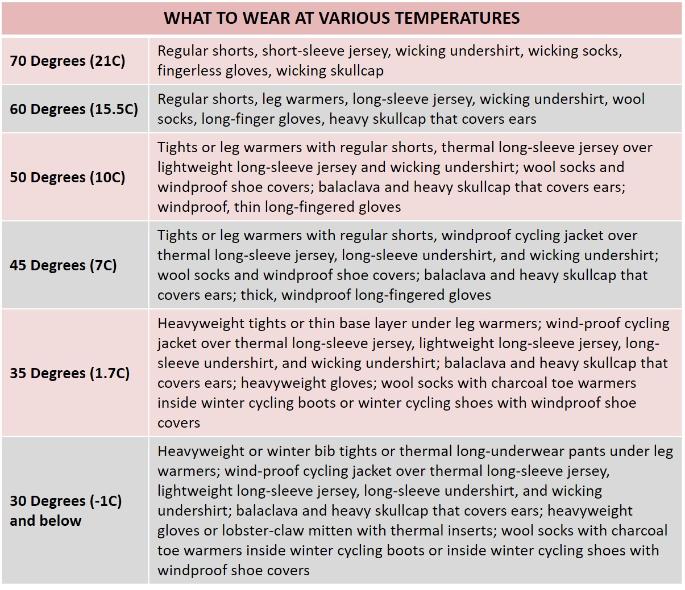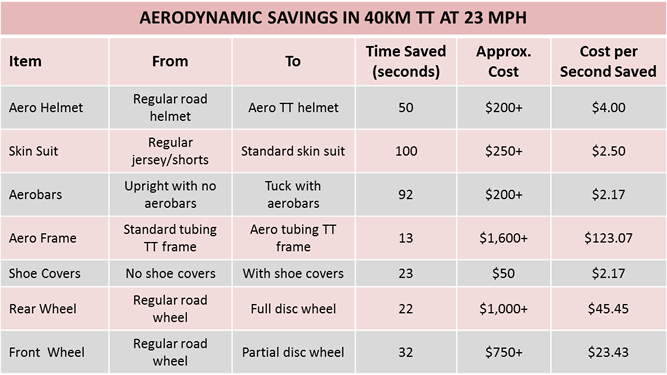Have the right gear?
OVERVIEW OF GEAR
Generally speaking, there are three categories of gear: bike gear, rider gear, and accessories. The following table summarizes the specific types of gear found in each category.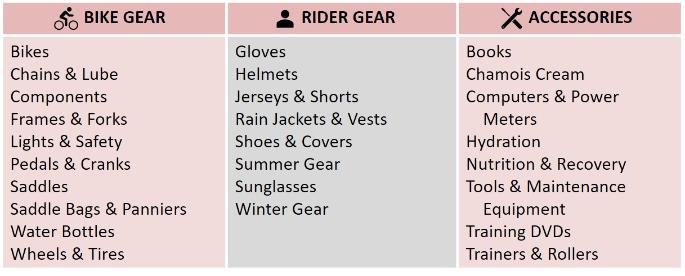
Rather than providing an exhaustive discussion of each type of gear, which is best left for individual consultation, I want to discuss three specific topics: training logs, winter gear, and racing gear.
TRAINING LOGS
How do you kee![]() p track of your training and racing data? When I started cycling in 2001, the only choice available for recording the data on daily training rides and races was a paper diary. I have one for each of the 17 years I’ve been cycling.
p track of your training and racing data? When I started cycling in 2001, the only choice available for recording the data on daily training rides and races was a paper diary. I have one for each of the 17 years I’ve been cycling.
I continue to use it, even though I also have two online repositories at the Cycling Analytics and Garmin Connect websites. This is a sample of my current diary with notes for the first week of the 2018 season starting on Monday, November 6th.
- Hours of sleep, plus “N” if I had a nap before dinner. Fatigue is based on a heart rate variability (HRV) app on my smartphone communicating with a Polar heart rate monitor giving me my sitting HR and HRV reading. “51” is my sitting HR first thing in the morning, while “40” is my HRV score. “G” = green (rested and ready for activity), “Y” = yellow (need rest/recovery), and “R” = red (complete cessation of activity). Also record pre- and post-workout weight. My daily HRV readings are entered into a spreadsheet that is sent to my coach at the end of the month. My daily weight is also entered into a spreadsheet, but is used to calculate my monthly average weight, which is added to the chart on the “My Lifestyle” page of this blog.
- Readings taken every Monday morning with a smartscale. The values are entered manually into a spreadsheet and sent to my coach at the end of the month.
- The data metrics from the day’s workout. They include: average speed/maximum speed, total miles, average HR/maximum HR, average power/maximum power, time of the workout, average cadence/maximum cadence, and the workout rating, which I usually expressed based on the training zone(s) of the workout. All of this data is automatically uploaded, displayed for analysis, and stored by two repository websites: Cycling Analytics and Garmin Connect.
- Brief notes about the workout, such as gears used, cadence target, and FTP/HR zones.
- Elapsed time of my flexibility warmup, nutritional intake during the workout, and calories burned.
- Brief notes about a strength workout, such as warmup/cooldown on the bike, hand weights, and barbell weight.
My entries in the early years were minimal because cycling computers only displayed speed, cadence, distance, miles traveled, and elapsed time. In recent years, affordable power meters, GPS, and free online data analysis/storage websites (like Cycling Analytics and Garmin Connect below) have been introduced.
Cycling Analytics (https://www.cyclinganalytics.com)
Garmin Connect (https://connect.garmin.com/)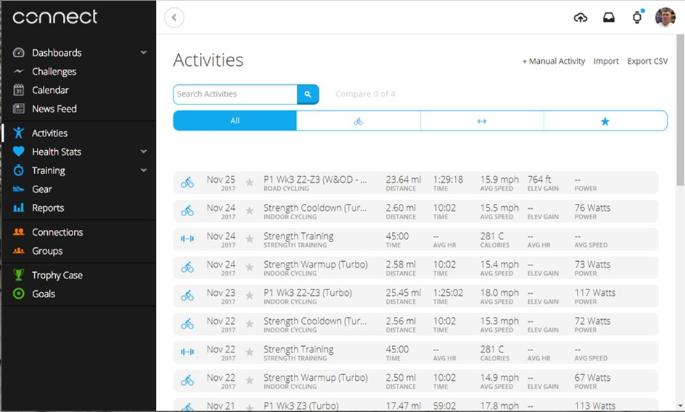
WINTER TRAINING GEAR
![]() If you are using a 52-week training plan, you are likely to be training outdoors on weekends during the winter, unless your local bike trail/roads are snow/slush covered and the temperature is below freezing. Then, you’ll be training indoors on those days.
If you are using a 52-week training plan, you are likely to be training outdoors on weekends during the winter, unless your local bike trail/roads are snow/slush covered and the temperature is below freezing. Then, you’ll be training indoors on those days.
But, if you are training outdoors, review the table below. Remember that it is based on the principle of layering: a windproof/thermal outer layer and gradually lighter-weight layers underneath on your core and extremities as the temperatures drop.
I was advised by a former coach to always wear leg warmers when the temperature drops below 65 degrees (18.3C). The reason is that the legs have far fewer thermal receptors than any other part of the body. Your legs, especially the knee, do not have a layer of protective body fat. Consequently, they will start to suffer nerve and muscle damage well before you feel any pain. So, to be safe, I always wear leg warmers when the temperature drops below 65 degrees (18.3C).
RACING GEAR
![]()
Time trial racing is all about reducing aerodynamic drag. The speed you can achieve on your bike is determined by two factors: how much power you can produce and wind resistance. The faster you go, the more wind drag you need to overcome.
Time trial-specific training addresses the power component, while aerodynamic gear helps reduce wind resistance. Before we discuss gear, however, let’s acknowledge what accounts for the largest percentage of drag while you’re racing. It is your body. It accounts for 60%-70% of the drag. Your gear accounts for the remaining 30%-40%.
The table below is adapted from several I’ve seen on online. I’ve recalculated the time savings based on my fastest 40 km TT speed. (Note: Halve the time saved for a 20 km time trial.)
So, what do you need for your first time trial if you’re on a budget? I would recommend clip-on aerobars first because, if you can hold a tuck position on your bike, it will mean an increase in power output and gets the most benefit out of the rest of your aero gear: shoe covers, aero helmet, and skin suit. The rest of the equipment, the aero bike frame and wheels, will produce marginal time savings which will only matter at a Masters National Championship level.
Have questions about your gear? Not sure if you’re using the right gear? Have questions or concerns about any aspect of your gear and its impact on your competitive goals. Chances are pretty good that I’ve faced the same challenges during the last 20 years of training and racing. Ask me anything!
Categories
Archives

